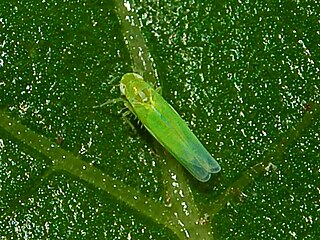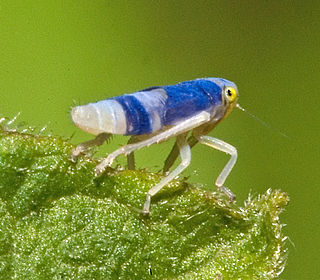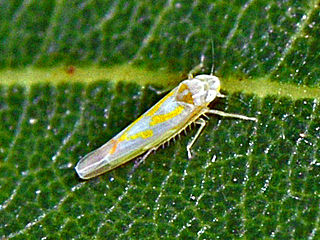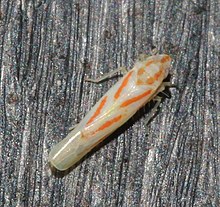
The glassy-winged sharpshooter is a large leafhopper insect from the family Cicadellidae, similar to other species of sharpshooter.

A leafhopper is the common name for any species from the family Cicadellidae. These minute insects, colloquially known as hoppers, are plant feeders that suck plant sap from grass, shrubs, or trees. Their hind legs are modified for jumping, and are covered with hairs that facilitate the spreading of a secretion over their bodies that acts as a water repellent and carrier of pheromones. They undergo a partial metamorphosis, and have various host associations, varying from very generalized to very specific. Some species have a cosmopolitan distribution, or occur throughout the temperate and tropical regions. Some are pests or vectors of plant viruses and phytoplasmas. The family is distributed all over the world, and constitutes the second-largest hemipteran family, with at least 20,000 described species.
Dziwneono (subfamily:Typhlocybinae) is a genus of Australian leafhoppers, with more than ten undescribed species. It's been described in 1972 by Polish entomologist Irena Dworakowska.

Brochosomes are intricately structured microscopic granules secreted by leafhoppers and typically found on their body surface and, more rarely, eggs. Brochosomes were first described in 1952 with the aid of an electron microscope. Brochosomes are hydrophobic and help keep the insect cuticle clean. These particles have also been found in samples of air and can easily contaminate foreign objects, which explains erroneous reports of brochosomes on other insects.
Aaka is a genus of hemiptera in the leafhopper family. There is only one species described in this genus, known as Aaka coera. It is distributed in Papua New Guinea.

Empoasca decipiens is a species of leafhopper belonging to the family Cicadellidae subfamily Typhlocybinae. The adults reach 3–4 millimetres (0.12–0.16 in) of length and a are homogenously green with whitish markings on its pronotum and vertex. E. decipiens is commonly referred to as the “green leafhopper” because of its colouration. The absence of clear stripes along the forewings can easily distinguish it from the similar leafhopper species E. vitis, but distinguishing it from other leafhoppers with the same colouration requires examination under a microscope. It is present in most of Europe, in the eastern Palearctic realm, in North Africa, in the Near East, and in the Afrotropical realm. Both nymphs and adults of this small insect are considered to be a very destructive pests on field crops, vegetables and greenhouse plants.
Sweta is a genus of leafhopper in the subfamily Typhlocybinae, with two species. The genus name is derived from the Sanskrit word for white, the type species S. hallucinata being predominantly whitish. The genus has an elongate pronotum which is unusual in Typhlocybinae and seen only in the Signoretiinae. A second species Sweta bambusana was described from China in 2012.
Jacobiasca formosana, the tea jassid, is an insect species belonging to the subfamily Typhlocybinae of the family Cicadellidae. Plant hosts include Gossypium (cotton) species and, notably, Camellia sinensis. The species is distributed throughout East, Southeast, and South Asia.

Macrosteles is a leafhopper genus in the tribe Macrostelini with more than 80 species, most in the northern hemisphere. Some species are known to migrate.

Typhlocybinae is a subfamily of insects in the leafhopper family, Cicadellidae. This is currently the second largest leafhopper subfamily based on the number of described species, but researchers believe there are so many taxa yet undescribed that it is probably the largest subfamily. Approximately 6000 species have been described to science so far.
Dayus is a genus of leafhoppers in the subfamily Typhlocybinae.

Alebrini is a leafhopper tribe in the subfamily Typhlocybinae.

Dikraneurini is a leafhopper tribe in the subfamily Typhlocybinae.

Alebra is a genus of leafhoppers in the subfamily Typhlocybinae. They genetically evolved their exoskeleton to achieve vibrant colors to defend themselves from predators.

Erythroneura infuscata, commonly known as Leafhopper is a species of leafhopper in the family Cicadellidae.
Tricella is a genus of robber flies in the family Asilidae. There is at least one described species in Tricella, T. calcar.
Amrasca biguttula, commonly known as the cotton jassid, is a subspecies of leafhopper belonging to the subfamily Typhlocybinae of family Cicadellidae. It is a pest of cotton, okra, and other crops in southern Asia.
Mileewinae is a small subfamily in the family Cicadellidae (leafhoppers). It is closely related to Typhlocybinae and contains species that were previously part of Cicadellinae.
Irena Dworakowska is a Polish entomologist who specialized in hemipterology.

Dikrella cruentata, the blackberry leafhopper, is a species of leafhopper belonging to the family Cicadellidae.











